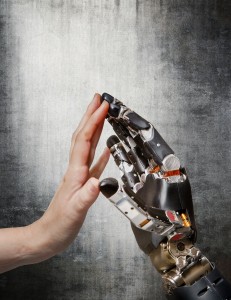Chicago researchers have made significant progress developing prosthetic limbs that can feel and touch.
Writing in the Proceedings of the National Academy of Sciences, the researchers say they’ve established a foundation to develop touch-sensitive prosthetic limbs.
This research could lead to a direct interface with the brain that could someday allow those who have lost limbs to, not only manipulate objects, but also to be able to touch and feel again.
“To restore sensory motor function of an arm, you not only have to replace the motor signals that the brain sends to the arm to move it around, but you also have to replace the sensory signals that the arm sends back to the brain,” said Sliman Bensmaia of the University of Chicago. “We think the key is to invoke what we know about how the brain of the intact organism processes sensory information, and then try to reproduce these patterns of neural activity through stimulation of the brain.”
The research by the Chicago team is part of a project, under way since 2006, called Revolutionizing Prosthetics at the Defense Advanced Research Projects Agency (DARPA). Researchers hope to create a modular artificial upper limb that will restore an amputee’s natural motor control and sensation.
The work being done by the Chicago research team focuses on developing the sensory aspects of the prosthetic limbs. Their experiments have been conducted with monkeys since the animals’ sensory systems are similar to humans.
The researchers said they’ve been able to identify patterns of neural activity which occur when an object is being manipulated and then artificially replicate those patterns.
In their first experiment, the researchers wanted to learn more about sensing where the skin was touched. They trained the test monkeys to recognize several types of physical contact with their fingers and then connected electrodes to parts of the monkey’s brains related to each of their fingers. Instead of using actual physical touches, they substituted them with electrical stimulation directed to those specific areas of their brains. As a result, the researchers found that the monkeys reacted to the electrical stimulation the same way they did with actual physical contact.

Experiments were conducted on rhesus macaque monkeys, such as the one in this picture taken at Kinnerasani Wildlife Sanctuary, Andhra Pradesh, India. (J.M. Garg/Wikimedia Commons)
The next area the researchers wanted to concentrate on was sense of pressure on the skin. They came up with an algorithm that would produce the proper amount of electrical current to artificially produce the sensation of pressure. As in their first experiment, the researchers found their test animals responded the same way whether the sensation was actually felt through their fingers or reproduced artificially.
Finally, the researchers looked into the natural sensations that are felt when a hand first touches or releases an object. Since this series of events also produces bursts of activity in the brain, the research team was able to provide direct stimulation to the brain that also duplicated those sensations.
The experiments helped the scientists develop computer instructions to be incorporated into a robotic prosthetic arm. They said that these instructions, working with the robotic appendage and through a neural interface, will be able to deliver sensory responses that mimic natural sensations of touch directly to the brain.
With the progress that the researchers have made with their animal experimentation, they hope to soon be able to test their devices during clinical trials with humans.






















Comments are closed.